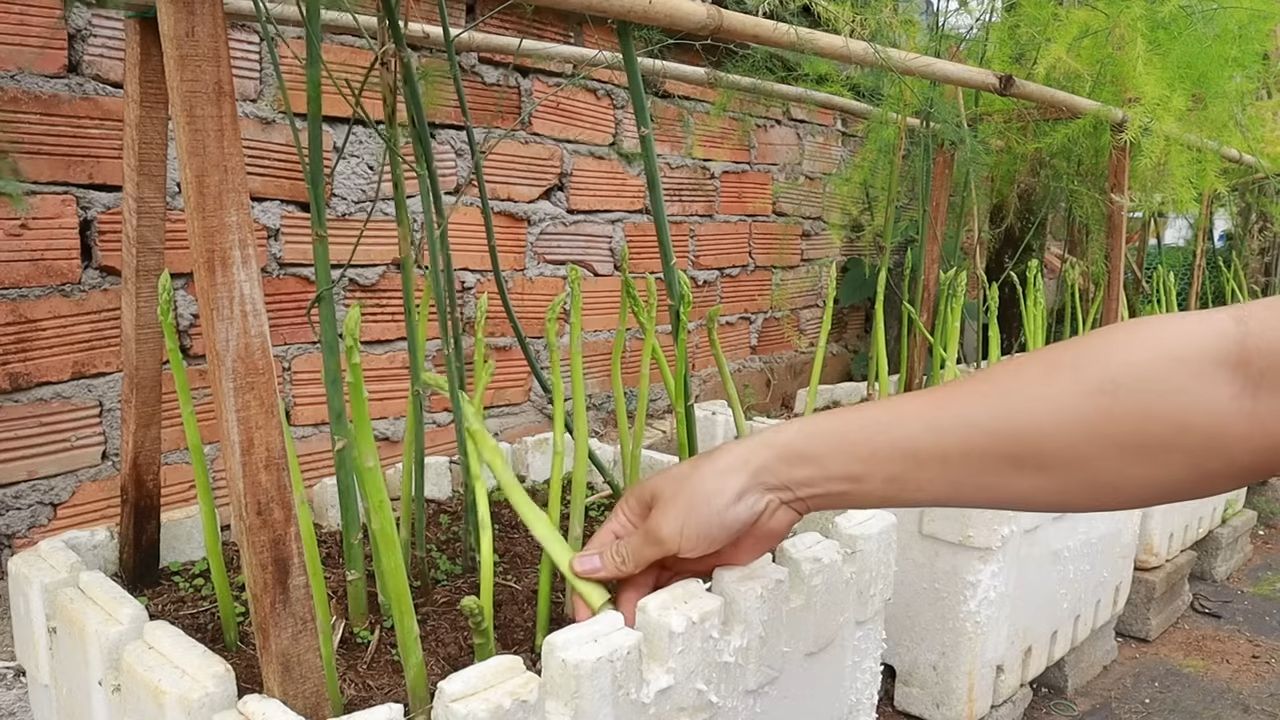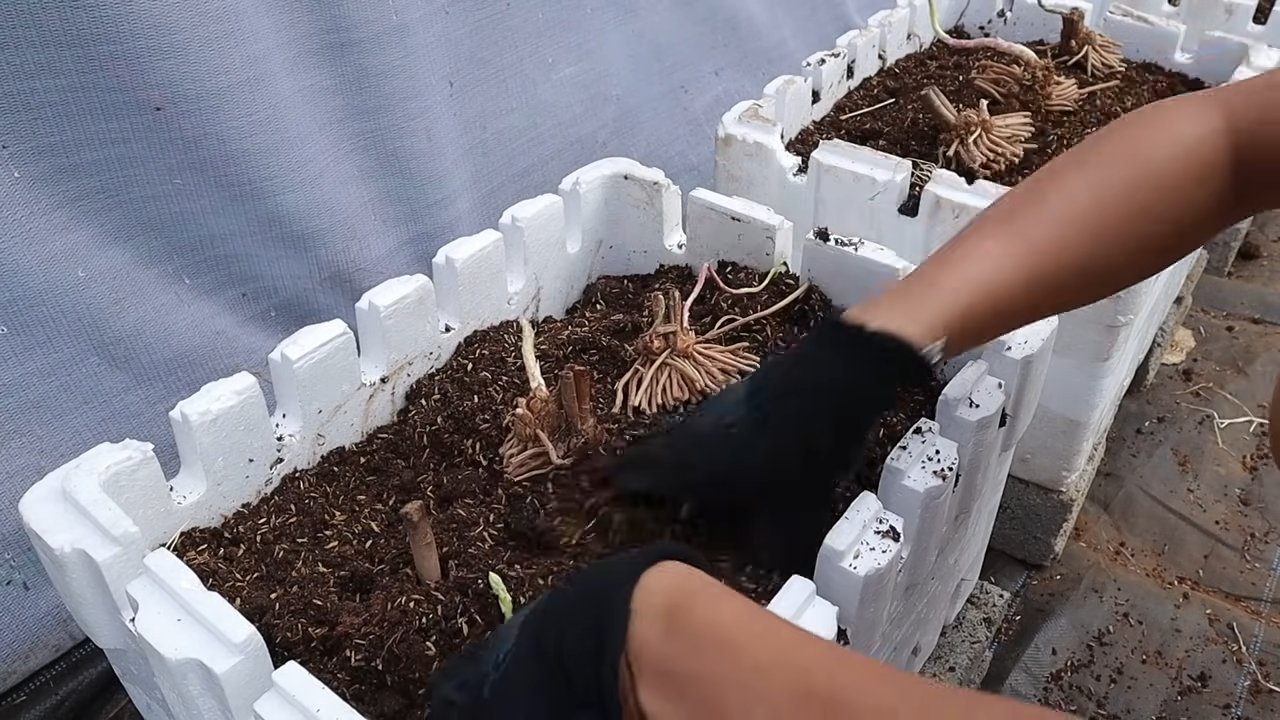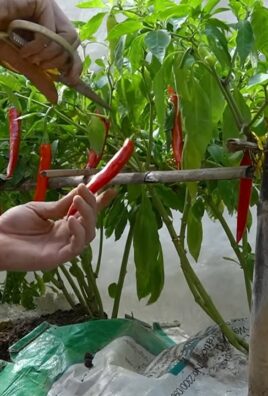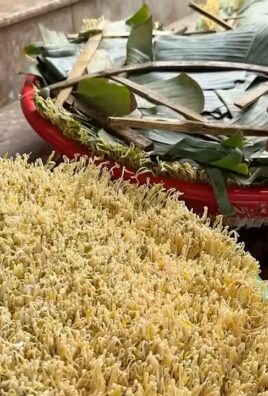Grow Asparagus at Home and unlock a world of fresh, flavorful spears right in your backyard! Imagine stepping outside and harvesting your own delicious asparagus, knowing exactly where it came from and how it was grown. Forget those bland, overpriced stalks at the grocery store – with a little know-how, you can cultivate a thriving asparagus patch that will provide you with years of culinary delight.
Asparagus has a rich history, dating back to ancient Greece and Rome, where it was prized for its medicinal properties and delicate flavor. The Romans even developed sophisticated methods for cultivating it! Today, the joy of growing your own food, including asparagus, is experiencing a resurgence. People are increasingly seeking ways to connect with nature, reduce their carbon footprint, and enjoy the unparalleled taste of homegrown produce.
But why should you learn to grow asparagus at home? Well, beyond the superior taste and freshness, it’s also a surprisingly low-maintenance crop once established. Plus, it’s a perennial, meaning you only plant it once and it will come back year after year! This DIY guide will walk you through everything you need to know, from choosing the right variety to preparing your soil and harvesting your first spears. I’m excited to share these simple tricks and hacks that will help you create a flourishing asparagus bed, even if you’re a complete beginner. Let’s get started!

Growing Asparagus at Home: A Beginner’s Guide
Asparagus, that delicious and slightly grassy spring vegetable, is surprisingly easy to grow at home! While it takes a little patience upfront, the rewards are years of fresh, homegrown asparagus spears. I’m going to walk you through everything you need to know to successfully cultivate your own asparagus patch.
Choosing Your Asparagus Variety
Before we get our hands dirty, let’s talk varieties. Different asparagus varieties offer different characteristics, so choosing the right one for your climate and preferences is key.
* ‘Jersey Knight’: This is a popular all-male hybrid known for its high yields and disease resistance. It’s a great choice for beginners.
* ‘Jersey Giant’: Similar to ‘Jersey Knight,’ this variety is also all-male and produces large, thick spears.
* ‘Mary Washington’: An older heirloom variety, ‘Mary Washington’ is reliable and adaptable, but it’s not all-male, so you’ll need to weed out any female plants (more on that later).
* ‘Purple Passion’: For something a little different, try ‘Purple Passion.’ It has a sweeter flavor and a beautiful purple color that turns green when cooked.
Preparing Your Asparagus Bed
Asparagus is a perennial, meaning it will come back year after year. Because of this, it’s crucial to choose a location and prepare the soil properly. This is a long-term investment, so let’s do it right!
* Sunlight: Asparagus needs at least 6-8 hours of direct sunlight per day.
* Soil: Well-drained soil is essential. Asparagus crowns will rot in soggy conditions. Aim for a sandy loam soil that’s rich in organic matter.
* Location: Choose a spot where you won’t be disturbing the asparagus bed for many years to come. Remember, it’s a perennial! Avoid areas where water tends to pool.
* Soil pH: Asparagus prefers a soil pH between 6.5 and 7.5. A soil test will help you determine your soil’s pH and whether you need to amend it with lime (to raise the pH) or sulfur (to lower the pH).
Planting Asparagus Crowns
Now for the fun part – planting! You can start asparagus from seed, but it takes much longer to establish. Planting crowns (one-year-old asparagus plants) is the faster and more common method.
What you’ll need:
* Asparagus crowns
* Spade or shovel
* Compost or well-rotted manure
* Bone meal (optional)
* Measuring tape or ruler
Step-by-Step Instructions:
1. Dig a Trench: Dig a trench that is approximately 12 inches wide and 6-8 inches deep. The length of the trench will depend on how many crowns you are planting.
2. Space the Crowns: Space the asparagus crowns about 12-18 inches apart within the trench. If you’re planting multiple rows, space the rows about 4-5 feet apart. This gives the plants plenty of room to spread out.
3. Create a Mound: At each planting location within the trench, create a small mound of soil mixed with compost or well-rotted manure. This will support the crown and encourage root growth. You can also mix in a little bone meal at this stage to provide phosphorus, which is beneficial for root development.
4. Position the Crown: Place the asparagus crown on top of the mound, spreading the roots out around it like a spider. Make sure the crown is facing upwards.
5. Cover the Crown: Gently cover the crown with about 2-3 inches of soil. Don’t bury it too deep at first. As the asparagus spears emerge, you’ll gradually fill in the trench.
6. Water Thoroughly: Water the newly planted crowns thoroughly. This will help settle the soil and encourage the roots to establish.
Caring for Your Asparagus Patch
Once your asparagus crowns are planted, it’s important to provide them with the care they need to thrive.
* Watering: Keep the soil consistently moist, especially during dry periods. Asparagus needs plenty of water to produce those delicious spears.
* Weeding: Asparagus doesn’t compete well with weeds, so regular weeding is essential. Hand-pull weeds carefully to avoid disturbing the asparagus roots. Mulching can also help suppress weeds.
* Fertilizing: Fertilize your asparagus patch in early spring with a balanced fertilizer or compost. Avoid over-fertilizing, as this can lead to excessive foliage growth at the expense of spear production.
* Mulching: Apply a layer of organic mulch, such as straw or wood chips, around the asparagus plants. This will help retain moisture, suppress weeds, and regulate soil temperature.
* Pest and Disease Control: Asparagus is relatively pest-resistant, but watch out for asparagus beetles. These small, colorful beetles can damage the spears and foliage. Hand-picking them off the plants is often the best solution. If you have a severe infestation, you can use an insecticidal soap or neem oil. Asparagus rust is a fungal disease that can affect the foliage. Ensure good air circulation around the plants and avoid overhead watering to prevent rust.
Harvesting Asparagus
Patience is key when it comes to harvesting asparagus. Do not harvest any spears during the first year after planting. This allows the plants to establish a strong root system. In the second year, you can harvest lightly for a few weeks. In the third year and beyond, you can harvest for a longer period, typically 6-8 weeks.
How to Harvest:
* Harvest when the spears are about 6-8 inches tall and the tips are still tightly closed.
* Use a sharp knife or asparagus knife to cut the spears at ground level. Be careful not to damage the crown or other emerging spears.
* Harvest spears every day or two during the peak season. The more you harvest, the more the plants will produce.
* Stop harvesting when the spears become thin and spindly. This indicates that the plants are starting to exhaust their energy reserves. Allow the remaining spears to fern out and replenish the plants’ energy for the following year.
Fern Care and Winter Preparation
After the harvest season, allow the asparagus plants to fern out. The ferns are essential for photosynthesis and storing energy for the next year’s growth.
* Let the ferns grow until they turn yellow or brown in the fall.
* Cut the ferns back to about 2 inches above the ground in late fall or early winter.
* Apply a layer of compost or well-rotted manure to the asparagus bed. This will provide nutrients and protect the crowns from the cold.
Dealing with Female Asparagus Plants (If Applicable)
If you’re growing a non-all-male variety like ‘Mary Washington,’ you’ll need to identify and remove any female plants. Female asparagus plants produce berries, which can spread and create unwanted seedlings. These seedlings will compete with your established asparagus plants and reduce spear production.
* Identify female plants by their red berries in the fall.
* Dig up and remove the female plants, being careful not to disturb the surrounding asparagus plants.
Troubleshooting Common Asparagus Problems
Even with the best care, you might encounter some problems with your asparagus patch. Here are a few common issues and how to address them:
* Thin Spears: Thin spears can be a sign of nutrient deficiency, overcrowding, or over-harvesting. Fertilize your asparagus patch, thin out overcrowded plants, and avoid over-harvesting.
* Yellowing Foliage: Yellowing foliage can be caused by nutrient deficiency, disease, or pests. Check the soil pH and nutrient levels, look for signs of disease or pests, and take appropriate action.
* Asparagus Beetles: As mentioned earlier, asparagus beetles can damage the spears and foliage. Hand-pick them off the plants or use an insecticidal soap or neem oil.
* Crown Rot: Crown rot is a fungal disease that can cause the asparagus crowns to rot. Ensure good drainage and avoid overwatering to prevent crown rot.
Enjoying Your Homegrown Asparagus
After all your hard work, it’s time to enjoy the fruits (or rather, vegetables) of your labor! Freshly harvested asparagus is incredibly delicious. Here are a few ideas for how to prepare it:
* Roasted Asparagus: Toss asparagus spears with olive oil, salt, and pepper, and roast them in a preheated oven at 400°F (200°C) for 10-15 minutes, or until tender-crisp.
* Grilled Asparagus: Grill asparagus spears over medium heat for 5-7 minutes, or until tender-crisp. Brush with olive oil and season with salt and pepper.
* Steamed

Conclusion
So, there you have it! Growing asparagus at home isn’t just a gardening project; it’s an investment in years of delicious, fresh, and incredibly rewarding harvests. Forget those bland, imported spears from the grocery store. Imagine stepping out into your own backyard and snipping vibrant, tender asparagus, bursting with flavor that you simply can’t find anywhere else. This isn’t just about saving money; it’s about elevating your culinary experience and connecting with the food you eat on a deeper level.
This DIY trick, while requiring patience upfront, offers unparalleled benefits in the long run. You’re in control of the entire process, from soil quality to watering schedules, ensuring your asparagus is grown organically and sustainably. Plus, the satisfaction of nurturing your own asparagus patch from tiny crowns to a thriving source of springtime delight is truly unmatched.
But don’t just take our word for it. We urge you to embark on this gardening adventure and experience the joy of growing asparagus at home firsthand. Start small, perhaps with just a few crowns, and gradually expand your patch as you gain confidence and experience.
Consider these variations to personalize your asparagus-growing journey:
* Experiment with different varieties: Jersey Knight, Mary Washington, and Purple Passion are all popular choices, each with its own unique flavor profile and growth characteristics. Research which varieties thrive best in your local climate and soil conditions.
* Companion planting: Enhance your asparagus patch by planting beneficial companion plants like tomatoes, basil, and parsley. These plants can help deter pests, improve soil health, and even enhance the flavor of your asparagus.
* Raised beds: If you have poor soil or limited space, consider growing your asparagus in raised beds. This allows you to create the ideal growing environment and provides better drainage.
* Container gardening: While asparagus prefers to be in the ground, you can grow dwarf varieties in large containers. Ensure the container is at least 2 feet deep and wide to accommodate the roots.
The key to success is patience and consistent care. Remember that asparagus takes a few years to mature, but the wait is well worth it. With a little planning and effort, you can enjoy a lifetime of delicious, homegrown asparagus.
We’re confident that you’ll find growing asparagus at home to be a rewarding and enjoyable experience. Don’t hesitate to reach out with any questions or challenges you encounter along the way. And most importantly, we encourage you to share your experiences with us! Post photos of your asparagus patch, share your tips and tricks, and let us know how your homegrown asparagus tastes. Together, we can inspire others to embrace the joys of gardening and enjoy the unparalleled flavor of fresh, homegrown produce. Let’s cultivate a community of asparagus enthusiasts!
Frequently Asked Questions (FAQ)
How long does it really take to grow asparagus from crowns?
Patience is key! While you might see some spears emerge in the first year after planting asparagus crowns, it’s crucial to resist the urge to harvest them. Allow the plants to establish a strong root system. In the second year, you can harvest sparingly, taking only a few spears per plant. By the third year, your asparagus patch should be mature enough for a full harvest, which typically lasts for 6-8 weeks in the spring. Remember, a well-established asparagus patch can produce for 15-20 years, so the initial wait is a worthwhile investment.
What kind of soil is best for growing asparagus?
Asparagus thrives in well-drained, sandy loam soil with a pH between 6.5 and 7.5. Before planting, amend your soil with plenty of organic matter, such as compost or well-rotted manure. This will improve drainage, fertility, and water retention. Avoid heavy clay soils, as they can become waterlogged and lead to root rot. If you have clay soil, consider growing your asparagus in raised beds or containers. A soil test can help you determine the pH and nutrient levels of your soil and guide you in making necessary amendments.
How much sun does asparagus need?
Asparagus needs at least 6-8 hours of direct sunlight per day to thrive. Choose a planting location that receives full sun throughout the growing season. Insufficient sunlight can result in weak, spindly spears and reduced yields. If you live in a particularly hot climate, some afternoon shade may be beneficial to prevent the plants from overheating.
How often should I water my asparagus?
Asparagus needs consistent moisture, especially during the growing season. Water deeply and regularly, ensuring the soil remains moist but not waterlogged. Avoid overhead watering, as this can promote fungal diseases. A good rule of thumb is to water when the top inch of soil feels dry to the touch. Mulching around the plants can help retain moisture and suppress weeds. During the dormant season (fall and winter), reduce watering frequency.
What are the most common asparagus pests and diseases?
Asparagus beetles are a common pest that can damage the spears and foliage. Handpicking the beetles and larvae is an effective control method for small infestations. You can also use insecticidal soap or neem oil. Asparagus rust is a fungal disease that can cause orange pustules on the stems and foliage. Ensure good air circulation around the plants and avoid overhead watering to prevent rust. Remove and destroy any infected plants. Fusarium wilt is another fungal disease that can cause yellowing and wilting of the plants. Choose disease-resistant varieties and practice crop rotation to prevent Fusarium wilt.
How do I harvest asparagus properly?
Harvest asparagus spears when they are 6-8 inches tall and about as thick as your finger. Use a sharp knife or asparagus knife to cut the spears at or slightly below the soil surface. Avoid damaging the crown or surrounding spears. Harvest spears every day or two during the peak of the harvest season. As the harvest season comes to an end, allow some spears to fern out. These ferns will provide energy for the plant to store in its roots for the following year’s growth.
Can I grow asparagus in containers?
Yes, you can grow asparagus in containers, but it requires a large container (at least 2 feet deep and wide) and a well-draining potting mix. Choose dwarf varieties of asparagus that are better suited for container growing. Ensure the container receives plenty of sunlight and water regularly. Fertilize the plants regularly with a balanced fertilizer. Container-grown asparagus may not produce as abundantly as plants grown in the ground, but it’s a great option for gardeners with limited space.
How do I fertilize my asparagus?
Fertilize your asparagus in early spring, before the spears emerge, with a balanced fertilizer (e.g., 10-10-10). You can also side-dress the plants with compost or well-rotted manure. Avoid over-fertilizing, as this can lead to excessive foliage growth at the expense of spear production. A soil test can help you determine the specific nutrient needs of your asparagus patch.
What do I do with the asparagus ferns in the fall?
In the fall, after the ferns have turned yellow or brown, cut them back to the ground. This will help prevent diseases and pests from overwintering in the foliage. You can leave the cut ferns on the ground as mulch or compost them. Applying a layer of compost or well-rotted manure around the base of the plants in the fall will provide nutrients for the following year’s growth.
Is growing asparagus at home worth the effort?
Absolutely! While it requires some initial patience and effort, growing asparagus at home is incredibly rewarding. You’ll enjoy years of fresh, delicious asparagus, grown organically and sustainably. The flavor of homegrown asparagus is far superior to store-bought varieties. Plus, the satisfaction of harvesting your own food is truly unmatched. So, grab some asparagus crowns and get started on your own asparagus-growing adventure today!




Leave a Comment